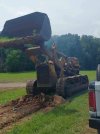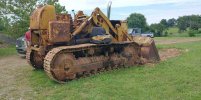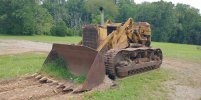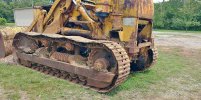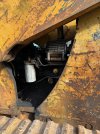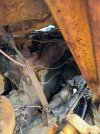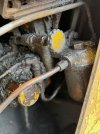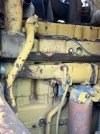The listing says it starts and runs but won’t brake or steer. I have a Cat D7E. Is the brake adjustment similar? If so I might go look at it and see if I can just adjust the brakes and get it steering enough to load on a lowboy. Any thoughts about what else I should look for?
-
Thank you for visiting HeavyEquipmentForums.com! Our objective is to provide industry professionals a place to gather to exchange questions, answers and ideas. We welcome you to register using the "Register" icon at the top of the page. We'd appreciate any help you can offer in spreading the word of our new site. The more members that join, the bigger resource for all to enjoy. Thank you!
You are using an out of date browser. It may not display this or other websites correctly.
You should upgrade or use an alternative browser.
You should upgrade or use an alternative browser.
Should I buy this Cat 977H?
- Thread starter ksliger
- Start date
JL Sargent
Senior Member
Can't think of anything.Any thoughts about what else I should look for?
Have you got a CAT master mechanic neighbor that can go look at this with you? Lets be honest, first glance looks like another clapped out farm track loader. The term Caviat Emptor comes to mind. Could there possibly be anything left of that under carriage? Nice looking D7E you have there by the way.
Dave Neubert
Senior Member
you can try to remove the triangle covers in the back and tighten up the brakes. But I bet they are wore out it is a big job to replace them I would get $4 or $5 grand to do it and my labor is cheep compared to others
1693TA
Senior Member
Brakes and steering clutches are a very big and expensive job to do on those. Just helped and guided a friend with one finishing last week.
UPDATE:
I talked to the current owner and got some info. He says that when the clutch\brake pedals are pushed it quickly feels like there is a loss of hydraulic pressure. He said if he mashes the pedal really fast, sometimes he can get it to slightly and briefly turn left or right. He said when this loss of pressure occurs it leaks oil out of the final drive. He claims to have tightened the brakes to spec per the service manual. He described this process correctly, tighten the adjuster all the way down and then back out 1.5 turns. He states that the motor starts right up every time and runs great. He thinks the final drive seals need to be replaced. Does all of this info sound like a leaking final drive seal? He claims that the final drives do not leak much oil. I thought the brakes were manually activated during the last half of pedal travel and that this was a mechanical process of tightening the brake band. I didn't realize the brakes relied on hydraulic pressure. Can someone please shed some light on this? The owner claims that the brakes and clutches are good, but just not getting enough hydraulic pressure. Is there anything else other than leaking final drive seals that would be a likely cause? I am going to look at the old beast in a couple of days. The price is really low. It could still possibly be a good deal, all things considered. Thanks in advance!
I talked to the current owner and got some info. He says that when the clutch\brake pedals are pushed it quickly feels like there is a loss of hydraulic pressure. He said if he mashes the pedal really fast, sometimes he can get it to slightly and briefly turn left or right. He said when this loss of pressure occurs it leaks oil out of the final drive. He claims to have tightened the brakes to spec per the service manual. He described this process correctly, tighten the adjuster all the way down and then back out 1.5 turns. He states that the motor starts right up every time and runs great. He thinks the final drive seals need to be replaced. Does all of this info sound like a leaking final drive seal? He claims that the final drives do not leak much oil. I thought the brakes were manually activated during the last half of pedal travel and that this was a mechanical process of tightening the brake band. I didn't realize the brakes relied on hydraulic pressure. Can someone please shed some light on this? The owner claims that the brakes and clutches are good, but just not getting enough hydraulic pressure. Is there anything else other than leaking final drive seals that would be a likely cause? I am going to look at the old beast in a couple of days. The price is really low. It could still possibly be a good deal, all things considered. Thanks in advance!
Last edited:
Dave Neubert
Senior Member
sounds like a money pit leave it be once you get into the finals you can spend big bucks there too
OzDozer
Senior Member
Post the serial number of the tractor if you want detailed information on it. There were numerous changes in the design of the 997H in this era.
I'm presuming it has levers for steering, and it's not pedal steer. The steering clutches and brakes on the 977H are oil-immersed and the steering is operated by hydraulic boosters which are provided with oil pressure from the transmission pump.
When you pull a steering lever, it actuates a hydraulic spool which sends pressurised oil to a clutch piston adjacent to the steering clutches (on the inner side of the clutches).
The piston is sealed by a teflon/nylon piston ring and the oil pressure acting on the piston pushes it inwards to disengage the clutch.
The braking mechanism is straight mechanical, with a scissor-style actuation increasing the pedal pressure on the band to provide adequate braking force.
If oil is leaking out of the final drive, you need to determine exactly where this oil is leaking from.
Oil can only leak out of the final drive in basically two places - from the sprocket metal-to-metal type seal (where it appears as an oil leak around the sprocket hub) or between the FD case and the tractors main rear housing.
Leaks in either of these places is unrelated to steering clutch problems, and any FD leaks require FD disassembly.
The oil level in the steering clutch compartments is considerably higher than the FD's. There is a metal-to-metal face type seal on the FD pinion that prevents the steering clutch oil and FD oil from mixing.
The steering clutches utilise the transmission oil for lube and cooling, but the FD's have their own supply of gear oil, which should be a much heavier grade of EP gear oil.
If you're lucky, there may be a simple problem in the steering clutch hydraulic system. This is where you would start. The steering clutch booster spool valves may not be opening correctly due to worn or damaged or badly adjusted linkages.
The steering clutch spool valves may be contaminated with dirt, rust or water, making them not operate correctly. There are small pistons and tiny orifices in the spool valves and these all need to be spotlessly clean, and in good condition to operate correctly.
If the transmission filter changes have been neglected, the filter may have become overloaded with debris, and because the filter is a bypass type, it will dump debris back into the transmission oil when the filter is blocked, and this will then find its way into the steering clutch spool valves.
If the steering clutch hydraulics are just fine for adjustment, cleanliness and correct operation, then the problem is the steering clutch piston seal is gone - and this involves major surgery, by way of complete steering clutch removal.
Often, these piston seals chew out when the bevel gear cross-shaft bearings have started to collapse, and this then allows the cross-shaft to drop, which chews out the teflon/nylon piston seal.
If there's no equipment attached to the rear of the tractor, you can access the bevel gear compartment by taking off the plate on the vertical face of the rear of the housing, and then by placing a crowbar under the cross-shaft or even just against the bevel gear, and wriggling it, you can determine if the bevel gear bearings are O.K. or if they need replacement. There should be zero movement here.
I'm presuming it has levers for steering, and it's not pedal steer. The steering clutches and brakes on the 977H are oil-immersed and the steering is operated by hydraulic boosters which are provided with oil pressure from the transmission pump.
When you pull a steering lever, it actuates a hydraulic spool which sends pressurised oil to a clutch piston adjacent to the steering clutches (on the inner side of the clutches).
The piston is sealed by a teflon/nylon piston ring and the oil pressure acting on the piston pushes it inwards to disengage the clutch.
The braking mechanism is straight mechanical, with a scissor-style actuation increasing the pedal pressure on the band to provide adequate braking force.
If oil is leaking out of the final drive, you need to determine exactly where this oil is leaking from.
Oil can only leak out of the final drive in basically two places - from the sprocket metal-to-metal type seal (where it appears as an oil leak around the sprocket hub) or between the FD case and the tractors main rear housing.
Leaks in either of these places is unrelated to steering clutch problems, and any FD leaks require FD disassembly.
The oil level in the steering clutch compartments is considerably higher than the FD's. There is a metal-to-metal face type seal on the FD pinion that prevents the steering clutch oil and FD oil from mixing.
The steering clutches utilise the transmission oil for lube and cooling, but the FD's have their own supply of gear oil, which should be a much heavier grade of EP gear oil.
If you're lucky, there may be a simple problem in the steering clutch hydraulic system. This is where you would start. The steering clutch booster spool valves may not be opening correctly due to worn or damaged or badly adjusted linkages.
The steering clutch spool valves may be contaminated with dirt, rust or water, making them not operate correctly. There are small pistons and tiny orifices in the spool valves and these all need to be spotlessly clean, and in good condition to operate correctly.
If the transmission filter changes have been neglected, the filter may have become overloaded with debris, and because the filter is a bypass type, it will dump debris back into the transmission oil when the filter is blocked, and this will then find its way into the steering clutch spool valves.
If the steering clutch hydraulics are just fine for adjustment, cleanliness and correct operation, then the problem is the steering clutch piston seal is gone - and this involves major surgery, by way of complete steering clutch removal.
Often, these piston seals chew out when the bevel gear cross-shaft bearings have started to collapse, and this then allows the cross-shaft to drop, which chews out the teflon/nylon piston seal.
If there's no equipment attached to the rear of the tractor, you can access the bevel gear compartment by taking off the plate on the vertical face of the rear of the housing, and then by placing a crowbar under the cross-shaft or even just against the bevel gear, and wriggling it, you can determine if the bevel gear bearings are O.K. or if they need replacement. There should be zero movement here.
Last edited:
Nige
Senior Member
If it's original the engine will carry the same Serial Number as the tractor. Should be 53A-something if my information is correct.I’ll try to locate it when I go see it this week.
Yes, I'm pretty certain its a 53AXXXX. Here are a few more pictures from the ad.
Attachments
Thank you Ankara. Can you or anyone recommend a good tester for hydraulic pressure? I am not sure what kinds of threads it will need.
So, I went out to look at it today and it was in better shape than I thought. The undercarriage looks to be pretty good. The roller surfaces are almost perfectly flat, the pins are straight with almost no wear, the sprockets are not too worn. The sprocket teeth come to a nice rounded-off tip and not a sharp point. The track pads all had bolts and there was only about an inch of tread left. It has a very new-looking turbo and a newer starter. I didn't see any major leaks. It has at least one new hydraulic hose for one of the lifting cylinders. The owner said it has been sitting since July when he won it at a local auction. I primed the manual fuel priming pump and felt good pressure. The batteries were almost dead but once we got them charged it roared to life. After a little while it settled down and sounded awesome! I didn't see any noticeable cracks in the exhaust manifold or observe any exhaust coming from anywhere in the engine compartment. Once it ran for a while he was able to get it in gear and drive forward and backward, and lift and curl the bucket. I was in a time crunch and didn't have time to check and drive it myself. After hearing the engine run I just told him I would buy it. I did notice that he had the pedals pushed all the way and they were bottomed out. While the batteries were charging, I took a look at the brake adjusters and turned them in several turns. I never felt them bottom out. I didn't have much time to mess with it but I am really wondering if they just need to be tightened per the manual (all the way down and then 1.5 back). I plan to do this when I go back to work on it some more. I also plan to check the steering clutch control gap and adjust to 3/16 if needed, per the manual. The final drives have small noticable spots of oil leakage on the outside but it doesn't look like more than a few drops here or there. The transmission was full of oil and it looked relatively clean. The range selector was full but looked milky. The oil in each steering clutch compartment was on the dipstick but milky. The crankcase oil was full and dark. I couldn't observe any water in the radiator and I'm sure it needs topped off. I did observe some fuel sputtering out from one of the fuel lines going into the top of the motor. Honestly not sure what could be causing that, but hopefully its minor. The guy said he hasn't done anything to it since winning it at auction. So, I plan to go replace all the filters and fluids onsite before I have it hauled back to my farm. I plan to just head to Cat tomorrow to get the fluids and filters. I've been pouring over the service manual and operator manual. I also plan to get a couple of new batteries for it. Oh, lastly it is going to need the seat replaced and a good pressure washing. Any other advice as to what I should do while I am there working on it? Any recommendations on the type of fluids I should go with? Thanks in advance! I am pretty excited that I think I scored a helluva good deal on a beastly old Traxcavator!
So, I went out to look at it today and it was in better shape than I thought. The undercarriage looks to be pretty good. The roller surfaces are almost perfectly flat, the pins are straight with almost no wear, the sprockets are not too worn. The sprocket teeth come to a nice rounded-off tip and not a sharp point. The track pads all had bolts and there was only about an inch of tread left. It has a very new-looking turbo and a newer starter. I didn't see any major leaks. It has at least one new hydraulic hose for one of the lifting cylinders. The owner said it has been sitting since July when he won it at a local auction. I primed the manual fuel priming pump and felt good pressure. The batteries were almost dead but once we got them charged it roared to life. After a little while it settled down and sounded awesome! I didn't see any noticeable cracks in the exhaust manifold or observe any exhaust coming from anywhere in the engine compartment. Once it ran for a while he was able to get it in gear and drive forward and backward, and lift and curl the bucket. I was in a time crunch and didn't have time to check and drive it myself. After hearing the engine run I just told him I would buy it. I did notice that he had the pedals pushed all the way and they were bottomed out. While the batteries were charging, I took a look at the brake adjusters and turned them in several turns. I never felt them bottom out. I didn't have much time to mess with it but I am really wondering if they just need to be tightened per the manual (all the way down and then 1.5 back). I plan to do this when I go back to work on it some more. I also plan to check the steering clutch control gap and adjust to 3/16 if needed, per the manual. The final drives have small noticable spots of oil leakage on the outside but it doesn't look like more than a few drops here or there. The transmission was full of oil and it looked relatively clean. The range selector was full but looked milky. The oil in each steering clutch compartment was on the dipstick but milky. The crankcase oil was full and dark. I couldn't observe any water in the radiator and I'm sure it needs topped off. I did observe some fuel sputtering out from one of the fuel lines going into the top of the motor. Honestly not sure what could be causing that, but hopefully its minor. The guy said he hasn't done anything to it since winning it at auction. So, I plan to go replace all the filters and fluids onsite before I have it hauled back to my farm. I plan to just head to Cat tomorrow to get the fluids and filters. I've been pouring over the service manual and operator manual. I also plan to get a couple of new batteries for it. Oh, lastly it is going to need the seat replaced and a good pressure washing. Any other advice as to what I should do while I am there working on it? Any recommendations on the type of fluids I should go with? Thanks in advance! I am pretty excited that I think I scored a helluva good deal on a beastly old Traxcavator!
Last edited:
UPDATE: I went out to look at the 997H again today. I put two new batteries in it and it started right up. I noticed that the motor has screw on fuel and oil filters. This makes me think someone may have swapped out the original D333 engine with something newer. I was unable to locate any SN on the motor. Can anyone identify the motor by these pictures?
Also, I tightened down the left and right brake adjustments in the rear. I got excited at first because there was enough resistance in the steering\brake pedal to stop it from bottoming out. However, once the engine was running, both left and right pedals bottomed out again. I also have adjusted both brake adjusters all the way in and can't go any further. Good news is that we were able to get a little braking capability on the left side. I don't know what else this could mean other than it needs a brake job. Any thoughts?
The steering clutches feel like they want to kick in and provide some resistance to the pedals but this quickly fades. Both steering clutch compartments have milky oil in them and seem low. I can't read the marks on the two small dipstick for the clutch compartments but the milky oil covers about an inch of the dipstick. Tomorrow I am going to drain each clutch compartment and fill with Cat TDTO oil. I am also going to swing by Cat tomorrow and see if they have hydraulic filters. Tomorrow I also plan on checking the steering clutches to make sure they are within spec for adjustment.
My goal is to get the old beast at least to a point where she can be steered with the steering clutches. If the brakes are truly shot then I am going to have to have them replaced. At this point, I got such a good deal on the 977H that even a $5K brake job will be worth it. Any thoughts on whether or not the brakes may improve with new oil and filters? Or are they strickly mechanical?
Thats all I can think of for now, thanks in advance for any feedback!
Also, I tightened down the left and right brake adjustments in the rear. I got excited at first because there was enough resistance in the steering\brake pedal to stop it from bottoming out. However, once the engine was running, both left and right pedals bottomed out again. I also have adjusted both brake adjusters all the way in and can't go any further. Good news is that we were able to get a little braking capability on the left side. I don't know what else this could mean other than it needs a brake job. Any thoughts?
The steering clutches feel like they want to kick in and provide some resistance to the pedals but this quickly fades. Both steering clutch compartments have milky oil in them and seem low. I can't read the marks on the two small dipstick for the clutch compartments but the milky oil covers about an inch of the dipstick. Tomorrow I am going to drain each clutch compartment and fill with Cat TDTO oil. I am also going to swing by Cat tomorrow and see if they have hydraulic filters. Tomorrow I also plan on checking the steering clutches to make sure they are within spec for adjustment.
My goal is to get the old beast at least to a point where she can be steered with the steering clutches. If the brakes are truly shot then I am going to have to have them replaced. At this point, I got such a good deal on the 977H that even a $5K brake job will be worth it. Any thoughts on whether or not the brakes may improve with new oil and filters? Or are they strickly mechanical?
Thats all I can think of for now, thanks in advance for any feedback!
Attachments
I still can't locate a serial number anywhere but it is for sure one of the later 977H's in the SN range. Lets call it 53A5555 until I can locate the actual SNIf it's original the engine will carry the same Serial Number as the tractor. Should be 53A-something if my information is correct.
I still can't locate the original serial number. I know that it is in the later range of the 977H SNs so lets call it 53A5555 for now.Post the serial number of the tractor if you want detailed information on it. There were numerous changes in the design of the 997H in this era.
I'm presuming it has levers for steering, and it's not pedal steer. The steering clutches and brakes on the 977H are oil-immersed and the steering is operated by hydraulic boosters which are provided with oil pressure from the transmission pump.
When you pull a steering lever, it actuates a hydraulic spool which sends pressurised oil to a clutch piston adjacent to the steering clutches (on the inner side of the clutches).
The piston is sealed by a teflon/nylon piston ring and the oil pressure acting on the piston pushes it inwards to disengage the clutch.
The braking mechanism is straight mechanical, with a scissor-style actuation increasing the pedal pressure on the band to provide adequate braking force.
If oil is leaking out of the final drive, you need to determine exactly where this oil is leaking from.
Oil can only leak out of the final drive in basically two places - from the sprocket metal-to-metal type seal (where it appears as an oil leak around the sprocket hub) or between the FD case and the tractors main rear housing.
Leaks in either of these places is unrelated to steering clutch problems, and any FD leaks require FD disassembly.
The oil level in the steering clutch compartments is considerably higher than the FD's. There is a metal-to-metal face type seal on the FD pinion that prevents the steering clutch oil and FD oil from mixing.
The steering clutches utilise the transmission oil for lube and cooling, but the FD's have their own supply of gear oil, which should be a much heavier grade of EP gear oil.
If you're lucky, there may be a simple problem in the steering clutch hydraulic system. This is where you would start. The steering clutch booster spool valves may not be opening correctly due to worn or damaged or badly adjusted linkages.
The steering clutch spool valves may be contaminated with dirt, rust or water, making them not operate correctly. There are small pistons and tiny orifices in the spool valves and these all need to be spotlessly clean, and in good condition to operate correctly.
If the transmission filter changes have been neglected, the filter may have become overloaded with debris, and because the filter is a bypass type, it will dump debris back into the transmission oil when the filter is blocked, and this will then find its way into the steering clutch spool valves.
If the steering clutch hydraulics are just fine for adjustment, cleanliness and correct operation, then the problem is the steering clutch piston seal is gone - and this involves major surgery, by way of complete steering clutch removal.
Often, these piston seals chew out when the bevel gear cross-shaft bearings have started to collapse, and this then allows the cross-shaft to drop, which chews out the teflon/nylon piston seal.
If there's no equipment attached to the rear of the tractor, you can access the bevel gear compartment by taking off the plate on the vertical face of the rear of the housing, and then by placing a crowbar under the cross-shaft or even just against the bevel gear, and wriggling it, you can determine if the bevel gear bearings are O.K. or if they need replacement. There should be zero movement here.
OzDozer
Senior Member
Your suspicions are correct, the engine is a much later 4.75" bore, 3306 or D333C engine.
You have scored a big win with that engine upgrade.
It sounds like you're up for a brake lining job, I'd have to opine there's no linings left. The brake operation is fully mechanical.
The steering clutch hydraulics are where to start on finding the steering problem. You need to find out the source of the milky oil. Milky oil mean water has got into the system, and water means corrosion.
You have scored a big win with that engine upgrade.
It sounds like you're up for a brake lining job, I'd have to opine there's no linings left. The brake operation is fully mechanical.
The steering clutch hydraulics are where to start on finding the steering problem. You need to find out the source of the milky oil. Milky oil mean water has got into the system, and water means corrosion.
631G
Senior Member
We’ve got some older dozers and scrapers. I’d call Costex and Regal to see what parts they have for the machine to be sure you can still get parts. Lots of our older stuff is getting sparse on parts from Cat or is outrageous on pricing. These two companies I have had great success with getting parts from that are great fit and great price
Wow, thats amazing news on the engine! The 977H has sat for many years with no ROPS and with the covers loose on the brake adjusters. Water could definitely have come in there. I am going to get new oil and filter in there tomorrow to see if that helps the steering clutches. I will report back. Any guess as to how much a Cat dealer would charge for a brake job?Your suspicions are correct, the engine is a much later 4.75" bore, 3306 or D333C engine.
You have scored a big win with that engine upgrade.
It sounds like you're up for a brake lining job, I'd have to opine there's no linings left. The brake operation is fully mechanical.
The steering clutch hydraulics are where to start on finding the steering problem. You need to find out the source of the milky oil. Milky oil mean water has got into the system, and water means corrosion.
Thank you, I will contact them. I'm hoping that I just need brakes at this point.We’ve got some older dozers and scrapers. I’d call Costex and Regal to see what parts they have for the machine to be sure you can still get parts. Lots of our older stuff is getting sparse on parts from Cat or is outrageous on pricing. These two companies I have had great success with getting parts from that are great fit and great price
I looked at a lot of pictures of D333C and 3306 motors and I am fairly certain that its a D333C in my 977H. By chance do you know the model number for the Cat fuel and oil filters I will need? I'm going to try to get all the oil and filters I'll need tomorrow at my local Cat dealer.Your suspicions are correct, the engine is a much later 4.75" bore, 3306 or D333C engine.
You have scored a big win with that engine upgrade.
It sounds like you're up for a brake lining job, I'd have to opine there's no linings left. The brake operation is fully mechanical.
The steering clutch hydraulics are where to start on finding the steering problem. You need to find out the source of the milky oil. Milky oil mean water has got into the system, and water means corrosion.

